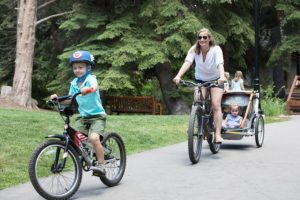Posted by: Tom Boyd
By Suzanne Silverthorn, Town of Vail

Vail’s public transportation system does so much more than get us from point A to point B. It connects us as a community in so many ways and is indicative of the journey Vail has taken as a global leader in sustainability.
It’s part of the GoPro Mountain Games effort to make sure everyone gets safely to-and-from the event, while also doing our best to minimize impact on the environment. Vail’s bus system can be a major asset in that effort.
[CLICK HERE TO PLAN YOUR VISIT]
Step on a bus and what you’ll see is a microcosm of our greater community. There are employees getting to or from their jobs, locals meeting for lunch or to run an errand, guests making their way to their next destination – and later, long after the sun goes down, there are the passengers who let someone else do the driving after a night on the town. Throughout the day, the conversations are varied and colorful, and in multiple languages. Just the way we like it.

In a way, Vail Transit is the great equalizer, convening passengers from all walks of like who share Vail’s values and its embrace of the natural environment. Today, Vail’s public transportation transports more than 3.2 million passengers and is one of the largest free public transit systems in the U.S. Not bad for a town with a year-round permanent population that barely tops 5,000!
The vision to curtail vehicular traffic was part of the original master planning for Vail – well before a four-lane highway intersected the community. Gravel parking areas gave way to risky public investments when multi-level parking structures were constructed, first on the outskirts of Vail Village, then later at the entry to Lionshead. The goal was to create a pedestrian-friendly environment in which transit would be used to connect the villages and later the neighborhoods. The result was a game changer for Vail.

Today, transit is one of Vail’s most treasured assets with buses providing nearly 88,000 hours of service a year while logging over 688,000 miles. Long before it became part of our global consciousness, residents have relied on transit as their primary mode of transportation, including Kevin Foley, a longtime member of the Vail Town Council. For Kevin, using public transportation is the best way to “think globally, act locally,” a phrase that was first used in Vail by a visiting keynote speaker in 1974. Kevin says Vail’s transit system is the best on the planet. “Not only is it good for the environment, but I get to meet everyone living in town and keep in touch with what’s going on,” he said. He’s also an advocate of CDOT’s highly successful Bustang service, which provides low-cost routes to Denver and back, as well as ECO Transit, the regional transportation service.

While Vail has enjoyed success with public transit since 1969, its commitment to sustainability remains a top priority. Diesel-powered buses were converted to hybrid buses in 2016 and a conversion to electric buses begins in 2020 to further reduce carbon emissions.
Of course, transit isn’t the only sustainable way to get around town. More than 15 miles of paved, multi-use recreation trails are available with recent adaptations to include ebikes on many sections. Two-wheeled commuters can even be rewarded through a valley wide Sole Power Challenge. And a “Bus it to Hike it” campaign will be in place again this summer to encourage getting to the trailheads in an environmentally-friendly way.
No matter the season, Vail is the perfect place to leave your car behind and experience the qualities that make Vail a special place.
Suzanne Silverthorn is director of communications for the town of Vail.

Share this Story:






















